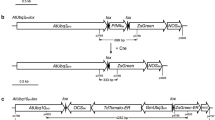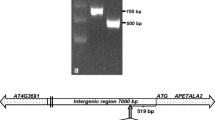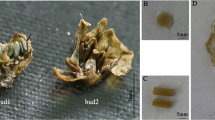Abstract
Previous studies have shown that the AtAGIP promoter derived from the Arabidopsis AGAMOUS (AG) second intron/enhancer specifies a carpel- and stamen-specific expression in its native host species, but not in heterologous species such as tobacco, which restricts its application in the engineering of male and female sterility. These findings also imply that the AG regulatory mechanism that has evolved in Arabidopsis may, to some extent, have diverged from that of tobacco. To test whether a similar chimeric promoter created using the AG second intron/enhancer can overcome this barrier of evolutionary divergence in closely related species, we generated forward- and reverse-oriented chimeric promoters, fPtAGIP and rPtAGIP, from the petunia AG second intron/enhancer (PtAGI) fragment and tested them in tobacco, which, like petunia, belongs to the Solanaceae family. Our results demonstrate that both fPtAGIP and rPtAGIP confer similar carpel- and stamen-specific expression without any leaky activity in vegetative tissues in tobacco as revealed by tissue-specific gene expression and tissue ablation. This pattern resembles that driven by the AtAGIP in Arabidopsis and indicates that the AG regulatory mechanism is more conserved between tobacco and petunia than between tobacco and Arabidopsis. The petunia-derived promoters also exhibited petal-specific activity, and their activities in floral organs were substantially influenced by the orientation of the PtAGI enhancer, with reverse-oriented enhancers displaying approximately double the effectiveness of forward-oriented enhancers. These two properties are novel and have not been observed previously with AtAGIP promoters. Furthermore, we found that PtAGIP promoter-driven tissue ablation is effective for engineering complete sterility in plants, and the resulting sterile trait is stable for at least three mitotic generations at various temperature regimes, which is important for the complete containment of seed-, pollen-, and fruit-mediated gene flow in field conditions.




Similar content being viewed by others
References
Bao X, Franks RG, Levin JZ, Liu Z (2004) Repression of AGAMOUS by BELLRINGER in floral and inflorescence meristems. Plant Cell 16:1478–1489
Block M, Debrouwer D (1993) Engineered fertility control in transgenic Brassica napus L: histochemical analysis of anther development. Planta 189:218–225
Block M, Debrouwer D, Moens T (1997) The development of a nuclear male sterility system in wheat: expression of the barnase gene under the control of tapetum specific promoters. Theor Appl Genet 95:125–131
Bomblies K, Dagenais N, Weigel D (1999) Redundant enhancers mediate transcriptional repression of AGAMOUS by APETALA 2. Dev Biol 216:260–264
Bowman JL, Smyth D, Meyerowitz EM (1989) Genes directing flower development in Arabidopsis. Plant Cell 1:37–52
Bowman JL, Smyth DR, Meyerowitz EM (1991) Genetic interactions among floral homeotic genes of Arabidopsis. Development 112:1–20
Busch MA, Bomblies K, Weigel D (1999) Activation of a floral homeotic gene in Arabidopsis. Science 285:585–587
Deyholos MK, Sieburth LE (2000) Separable whorl-specific expression and negative regulation by enhancer elements within the AGAMOUS second intron. Plant Cell 12:1799–1810
Drews GN, Bowman JL, Meyerowitz EM (1991) Negative regulation of the Arabidopsis homeotic gene AGAMOUS by the APETALA2 product. Cell 65:991–1002
Gomez MD, Beltran JP, Canas LA (2004) The pea END1 promoter drives anther-specific gene expresión in different plant species. Planta 219:967–981
Gustincich S, Manfioletti G, Del Sal GC, Schneider C, Carnici PC (1991) A fast method for high-quality genomic DNA extraction from whole human blood. Biotechniques 11:298–302
Hofig KP, Moller R, Donaldson L, Putterill J, Walter C (2006) Towards male sterility in Pinus radiata—a stilbene synthase approach to genetically engineer nuclear male sterility. Plant Biotechnol J 4:333–343
Hong RL, Hamaguchi L, Busch MA, Weigel D (2003) Regulatory elements of the floral homeotic gene AGAMOUS identified by phylogenetic footprinting and shadowing. Plant Cell 15:1296–1309
Horsch RB, Fry JE, Hoffmann NL, Wallroth M, Eichholtz D, Rogers SG, Fraley RT (1985) A simple and general method for transferring genes into plants. Science 227:1229–1231
Jefferson RA, Kavanagh TA, Bevan MW (1987) GUS fusions: β-glucuronidase as a sensitive and versatile gene fusion marker in higher plants. EMBO J 6:3901–3907
Kapoor M, Tsuda S, Tanaka Y, Mayama T, Okuyama Y, Tsuchimoto S, Takatsuji H (2002) Role of petunia pMADS3 in determination of floral organ and meristem identity, as revealed by its loss of function. Plant J 32:115–127
Kater MM, Colombo L, Franken J, Busscher M, Masiero S, Campagne MML, Angenent GC (1998) Multiple AGAMOUS homologs from cucumber and petunia differ in their ability to induce reproductive organ fate. Plant Cell 10:171–182
Kobayashi K, Munemura I, Hinata K, Yamamura S (2006) Bisexual sterility conferred by the differential expression of Barnase and Barstar: a simple and efficient method of transgene containment. Plant Cell Rep 25:1347–1354
Konagaya K, Ando S, Kamachi S, Tsuda M, Tabei Y (2008) Efficient production of genetically engineered, male-sterile Arabidopsis thaliana using anther-specific promoters and genes derived from Brassica oleracea and B. rapa. Plant Cell Rep 27:1741–1754
Kramer EM, Alejandra J, Stilio VSD (2004) Patterns of gene duplication and functional evolution during the diversification of the AGAMOUS subfamily of MADS box genes in angiosperms. Genetics 166:1011–1023
Lannenpaa M, Hassinen M, Ranki A, Holtta-Vuori M, Lemmetyinen J, Keinonen K, Sopanen T (2005) Prevention of flower development in birth and other plants using a BpFULL1::BARNASE construct. Plant Cell Rep 24:69–78
Lee YH, Chung KH, Kim HU, Jin YM, Kim HI, Park BS (2003) Induction of male sterile cabbage using a tapetum-specific promoter from Brassica campestris L. ssp. pekinensis. Plant Cell Rep 22:268–273
Lemmetyinen J, Keinonen K, Sopanen T (2004) Prevention of the flowering of a tree, silver birch. Mol Breed 13:243–249
Liu Z, Liu Z (2008) The second intron of AGAMOUS drives carpel- and stamen-specific expression sufficient to induce complete sterility in Arabidopsis. Plant Cell Rep 27:855–863
Lohmann JU, Hong RL, Hobe M, Busch MA, Parcy F, Simson R, Weigel D (2001) A molecular link between stem cell regulation and floral patterning in Arabidopsis. Cell 105:793–803
Luo H, Lee J-Y, Hu Q, Nelson-Vasilchik K, Eitas TK, Lickwar C, Kausch AP, Chandlee JM, Hodges TK (2006) RTS, a rice anther-specific gene is required for male fertility and its promoter sequence directs tissue-specific gene expression in different plant species. Plant Mol Biol 62:397–408
Mandel MA, Bowman JL, Kempin SA, Ma H, Meyerowitz EM, Yanofsky MF (1992) Manipulation of flower structure in transgenic tobacco. Cell 71:133–143
Mariani C, DeBeuckeleer M, Trueltner J, Leemans J, Goldberg RB (1990) Induction of male sterility in plants by a chimeric ribonuclease gene. Nature 347:737–741
Mariani C, Gossele V, Beuckeleer MD, Block MD, Goldburg RB, Greef WD, Leemans J (1992) A chimaeric ribonuclease-inhibitor gene restores fertility to male sterile plants. Nature 357:384–387
Mayer KF, Schoof H, Haecker A, Lenhard M, Jurgens G, Laux T (1998) Role of WUSCHEL in regulating stem cell fate in the Arabidopsis shoot meristem. Cell 95:805–815
Nilsson O, Wu E, Wolfe DS, Weigel D (1998) Genetic ablation of flowers in transgenic Arabidopsis. Plant J 15:799–804
Palmiter RD, Behringer RR, Quaife CJ, Maxwell FM, Maxwell IH, Brinster RL (1987) Cell lineage ablation in transgenic mice by cell-specific expression of a toxin gene. Cell 50:435–443
Parcy F, Nilsson O, Busch MA, Lee I, Weigel D (1998) A genetic framework for floral patterning. Nature 395:561–566
Roque E, Gomez MD, Ellul P, Wallbraun M, Madueno F, Beltran JP, Canas LA (2007) The PsEND1 promoter: a novel tool to produce genetically engineered male-sterile plants by early anther ablation. Plant Cell Rep 26:313–325
Sieburth LE, Meyerowitz EM (1997) Molecular dissection of the AGAMOUS control region shows that cis elements for spatial regulation are located intragenically. Plant Cell 9:355–365
Skinner JS, Meilan R, Ma C, Strauss SH (2003) The Populus PTD promoter imparts floral-predominant expression and enables high levels of floral-organ ablation in Populus, Nicotiana and Arabidopsis. Mol Breed 12:119–132
Thorsness MK, Kandasamy MK, Nasrallah ME, Nasrallah JB (1991) A Brassica S-Locus gene promoter targets toxic gene expression and cell death to the pistil and pollen of transgenic Nicotiana. Dev Biol 143:173–184
Thorsness MK, Kandasamy MK, Nasrallah ME, Nasrallah JB (1993) Genetic ablation of floral cells in Arabidopsis. Plant Cell 5:253–261
Twell D (1995) Diphtheria toxin-mediated cell ablation in developing pollen: vegetative cell ablation blocks generative cell migration. Protoplasma 187:144–154
Wang H-Z, Hu B, Chen G-P, Shi N-N, Zhao Y, Yin Q-C, Liu J-J (2008) Application of Arabidopsis AGAMOUS second intron for the engineered ablation of flower development in transgenic tobacco. Plant Cell Rep 27:251–259
Wei H, Meilan R, Brunner AM, Skinner JS, Ma K, Gandhi HT, Strauss SH (2007) Field trial detects incomplete barstar attenuation of vegetative cytotoxicity in Populus trees containing a poplar LEAFY promoter::barnase sterility transgene. Mol Breed 19:69–85
Weigel D, Alvarez J, Smyth DR, Yanofsky MF, Meyerowitz EM (1992) LEAFY controls floral meristem identity in Arabidopsis. Cell 69:843–859
Yanofsky MF, Ma H, Bowman JL, Drews GN, Feldmann KA, Meyerowitz EM (1990) The protein encoded by the Arabidopsis homeotic gene AGAMOUS resembles transcription factors. Nature 346:35–39
Zahn LM, Leebens-Mack JH, Arrington JM, Hu Y, Landherr L, dePamphilis CW, Becker A, Theissen G, Ma H (2006) Conservation and divergence in the AGAMOUS subfamily of MADS-box genes: evidence of independent sub- and neofunctionalization events. Evol & Dev 8:30–45
Acknowledgments
We thank Mr. Dennis Bennett for his excellent technical assistance. This study was funded by the United States Department of Agriculture (USDA)—Agricultural Research Service Headquarter 2007 classes of postdoctoral grants and a USDA Cooperative State Research, Education, and Extension Service Biotechnology Risk Assessment Research grant (2006-03701).
Author information
Authors and Affiliations
Corresponding author
Rights and permissions
About this article
Cite this article
Yang, Y., Singer, S.D. & Liu, Z. Petunia AGAMOUS Enhancer-Derived Chimeric Promoters Specify a Carpel-, Stamen-, and Petal-Specific Expression Pattern Sufficient for Engineering Male and Female Sterility in Tobacco. Plant Mol Biol Rep 29, 162–170 (2011). https://doi.org/10.1007/s11105-010-0215-z
Published:
Issue Date:
DOI: https://doi.org/10.1007/s11105-010-0215-z




